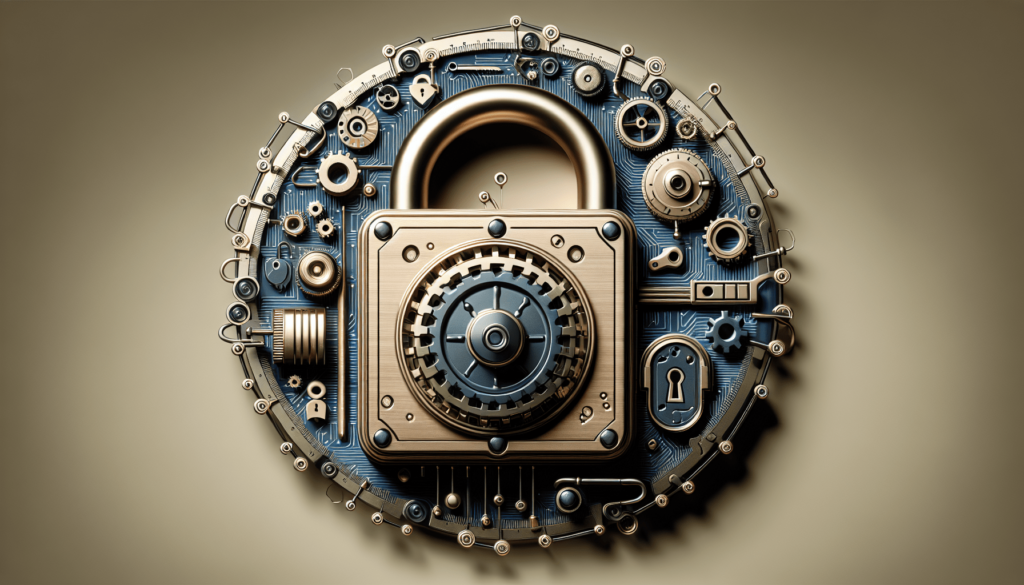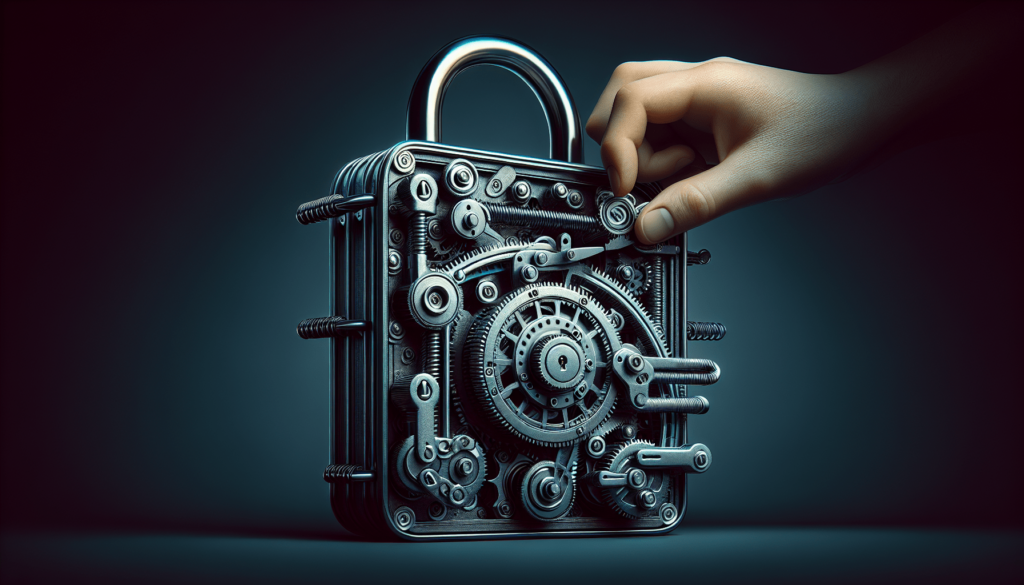Have you ever worried about the safety of your belongings, especially your valuable gear? Whether it’s your camera, laptop, or even your musical instruments, keeping them safe from theft is crucial. This article explores effective strategies and practical tips to secure your gear and provide you with peace of mind. By implementing these measures, you can minimize the risk of theft and protect your valuable possessions.

Physical Security Measures
Choose secure gear bags
When it comes to protecting your gear from theft, it all starts with choosing the right gear bags. Opt for bags that have secure and durable materials, such as slash-resistant fabric or reinforced stitching. Look for bags with multiple compartments that can be securely closed with zippers or fasteners. Additionally, consider bags that have hidden pockets or compartments to further deter thieves.
Use padlocks and combination locks
Adding padlocks or combination locks to your gear bags is another effective physical security measure. This is particularly useful when you need to leave your gear unattended for a short period of time, such as during a quick coffee break. Ensure that the locks you choose are sturdy and cannot be easily manipulated by potential thieves.
Invest in anti-theft backpacks
Anti-theft backpacks are specifically designed to deter thieves and protect your gear. These backpacks usually have features such as hidden zippers, cut-proof materials, and lockable compartments. Some even come with integrated security systems that use GPS tracking or alarms to further enhance their security capabilities. Investing in an anti-theft backpack can provide you with invaluable peace of mind, especially when you are traveling or in crowded areas.
Secure gear with cable locks
Cable locks are an excellent way to secure your gear when you need to leave it unattended in public spaces. These locks consist of a sturdy cable that can be looped through the handles or straps of your gear bags, and then secured to a stationary object, such as a table or chair. Cable locks are lightweight and easy to carry, making them a convenient choice for photographers and videographers on the go.
Home Security
Install security cameras
One of the most effective ways to secure your gear at home is by installing security cameras. These cameras act as a deterrent to potential thieves, as they know they are being watched. Additionally, in the unfortunate event of a theft, having security cameras can provide valuable evidence for law enforcement and insurance claims.
Use smart locks
Smart locks are a convenient and secure way to protect your gear at home. These locks can be controlled remotely using a smartphone or other mobile devices, allowing you to lock and unlock your doors without the need for traditional keys. Some smart locks even offer features such as temporary access codes, activity logs, and notifications for added security.
Keep gear in a locked room or safe
Keeping your gear in a locked room or a safe is an essential step towards its protection. Designate a specific room or area in your home that can be securely locked, and store your gear there when it is not in use. Alternatively, invest in a quality safe that is specifically designed to protect valuable items such as cameras, lenses, and other gear.
Utilize alarm systems
Installing alarm systems in your home provides an additional layer of security for your gear. These systems can detect unauthorized entry and trigger alarms, alerting you and potentially scaring away the intruders. Consider choosing alarm systems that are specifically designed for home security and offer features such as motion sensors, surveillance cameras, and remote monitoring capabilities.
Vehicle Security
Park in well-lit areas
When parking your vehicle, always choose well-lit areas that are visible to the public. Thieves are less likely to target vehicles parked in well-lit areas as they are more exposed and have a higher chance of being caught. Avoid parking in dimly lit or isolated spots where your vehicle and gear may be vulnerable to theft.
Install a car alarm
Car alarms are an effective deterrent against vehicle theft. These systems can emit loud sirens and flashing lights when someone attempts to break into your vehicle or tamper with it. Make sure to install a car alarm that is specifically designed for your vehicle and offers features such as shock sensors, remote arming/disarming, and tamper-proof technology.
Use steering wheel locks
Steering wheel locks are simple yet effective anti-theft devices that physically prevent thieves from driving away with your vehicle. These locks are easy to use and attach to your steering wheel, making it virtually impossible to steer the vehicle without removing the lock. Steering wheel locks act as a visible deterrent and can significantly increase the time and effort required for thieves to steal your vehicle and gear.
Hide valuable gear from view
One of the simplest yet often overlooked vehicle security measures is to keep your valuable gear out of sight. Place your gear in the trunk or a locked compartment inside your vehicle, or use a car cover to conceal it from prying eyes. Thieves are more likely to target vehicles that display valuable gear in plain sight, so take precautions to keep your gear hidden whenever it is left unattended in your vehicle.
Public Setting Precautions
Keep gear in sight
When you are out in public settings, always keep your gear within your line of sight. Avoid placing it down or leaving it unattended, even for a moment. By keeping a watchful eye on your gear, you can deter potential thieves and quickly respond if anyone attempts to steal it.
Utilize buddy systems
Whenever possible, travel or work in groups and establish a buddy system with fellow photographers or videographers. By watching out for each other’s gear, you create an extra layer of security and decrease the chances of theft. Your buddy can keep an eye on your gear while you are occupied, and vice versa.
Avoid leaving gear unattended
Leaving your gear unattended, even temporarily, can provide an opportunity for theft. Whenever you need to step away from your gear, ask someone you trust to keep an eye on it or take it with you if possible. It’s always better to be safe than sorry when it comes to the security of your valuable equipment.
Use discreet gear bags
Using discreet gear bags can reduce the chances of attracting unwanted attention. A bag that doesn’t scream “expensive camera equipment inside” is less likely to catch the eye of potential thieves. Opt for bags that look more like regular backpacks or messenger bags rather than dedicated camera gear bags.

Online Security Measures
Password protect electronic devices
To protect your gear and data in the online realm, start by password protecting all your electronic devices, such as cameras, laptops, and smartphones. Use strong and unique passwords that cannot be easily guessed. This prevents unauthorized access to your devices and the sensitive information they may contain.
Encrypt sensitive data
Encrypting sensitive data adds an extra layer of security, making it difficult for hackers to decipher or access your information. Use encryption software to protect your files, especially those containing client data, confidential information, or personal details. This way, even if your gear gets stolen, the thieves won’t be able to access your encrypted data.
Use reputable e-commerce platforms
When purchasing gear online, make sure to use reputable e-commerce platforms. Stick to well-known and trusted websites that have secure payment gateways and strong customer protection policies. Avoid purchasing from unfamiliar or suspicious websites to minimize the risk of falling victim to scams or counterfeit products.
Enable two-factor authentication
Two-factor authentication adds an extra layer of security to your online accounts. By enabling this feature, you will need to provide a second form of verification, such as a unique code sent to your mobile device, in addition to your regular login credentials. This makes it more difficult for unauthorized individuals to gain access to your accounts, even if they somehow obtain your password.
Insurance and Documentation
Ensure your gear is adequately insured
One of the most important aspects of securing your gear is ensuring that it is adequately insured. Accidents and theft can happen despite all precautions, and having insurance coverage can provide you with financial protection and peace of mind. Contact your insurance provider to discuss options for specialized equipment insurance or include your gear in your existing homeowner’s or renter’s insurance policies.
Keep copies of receipts and serial numbers
Keeping copies of receipts and serial numbers for your gear is crucial when it comes to insurance claims and police reports. These documents provide proof of ownership and can assist in the recovery or replacement of stolen gear. Take photos or make copies of your receipts and record the serial numbers of all your equipment, including cameras, lenses, and accessories.
Take photographs or make inventory lists of gear
In addition to keeping receipts and serial numbers, it is advisable to take photographs or make inventory lists of your gear. This documentation serves as visual proof of your equipment and can help streamline the claims process. Include details such as brand, model, and any distinguishing marks or features that can aid in identification.
Report theft promptly
In the unfortunate event that your gear is stolen, it is essential to report the theft promptly. Contact the local authorities and provide them with the details of the stolen equipment, including the photographs, receipts, and serial numbers. Additionally, inform your insurance provider as soon as possible to initiate the claims process.
Environmental Considerations
Protect gear from weather elements
Weather elements such as rain, extreme temperatures, and humidity can damage your gear. Protect your equipment from these environmental factors by using waterproof covers or cases, storing gear in dry and temperature-controlled areas, and avoiding exposing it to direct sunlight for extended periods.
Store gear in temperature-controlled areas
Extreme temperatures can affect the performance and lifespan of your gear. Whenever possible, store your equipment in temperature-controlled areas, such as climate-controlled rooms or cabinets. This helps to prevent damage caused by heat, cold, or rapid temperature fluctuations.
Invest in protective cases
Investing in protective cases is a worthwhile investment to safeguard your gear from accidental damage or rough handling. Look for cases that are specifically designed for your equipment and offer features such as shock absorption, waterproofing, and customizable foam padding. A well-padded and sturdy case can provide an added layer of protection during transport and storage.
Avoid leaving gear unattended outdoors
Leaving your gear unattended outdoors increases its vulnerability to theft, damage, or loss. Whenever possible, refrain from leaving your equipment exposed outside, even if it’s just for a short while. Secure it inside your vehicle, keep it within your line of sight, or return it to a secure indoor location to mitigate the risks associated with leaving it unattended outdoors.
Travel Security
Use TSA-approved locks
If you are traveling with gear that needs to go through airport security, opt for TSA-approved locks. These locks can be opened and re-locked by TSA screeners using special tools, allowing them to inspect your gear without causing damage. Using TSA-approved locks ensures the security of your gear while still complying with airport regulations.
Secure gear during transit with straps or wraps
During transit, whether it’s by plane, train, or other means, secure your gear with straps or wraps. These can prevent your gear from shifting or getting damaged during bumpy or turbulent rides. Consider using adjustable straps, protective wraps, or padded dividers to keep your equipment safe and protected.
Keep important gear close during flights
When traveling by plane, always keep your most critical and valuable gear with you as carry-on luggage. This includes cameras, lenses, memory cards, and other high-value items. In the unfortunate event of lost or delayed baggage, having your essential gear with you ensures that you can continue working or documenting your journey without major disruptions.
Choose reliable transportation options
When traveling with your gear, choose reliable transportation options that prioritize security. Research and select reputable transportation companies or services that have a track record of safe and secure handling of valuable items. Avoid using untrusted or unknown transportation options, especially in unfamiliar or high-risk areas.
Community and Networking
Join local gear-sharing communities
Joining local gear-sharing communities can provide you with valuable insights and resources regarding gear security. These communities often consist of fellow photographers or videographers who can share their experiences and recommend best practices for protecting gear. By networking with like-minded individuals, you can stay updated on the latest security measures and potentially collaborate on equipment protection initiatives.
Participate in online forums for gear security tips
Online forums dedicated to photography or videography often have dedicated sections or threads that discuss gear security tips and experiences. Participating in these forums can expose you to a wealth of knowledge from experienced professionals or passionate enthusiasts. Share your own experiences, ask questions, and learn from others’ insights to enhance your gear security measures.
Create partnerships with fellow photographers/videographers
Creating partnerships or forming a group with fellow photographers or videographers can provide benefits in terms of gear security. By working together, you can watch out for each other’s gear, share responsibilities for gear protection, and deter potential thieves with your presence. These partnerships can also lead to collaborations or joint projects, further enriching your professional network.
Share information about theft incidents in the community
In the unfortunate event of theft, sharing information about incidents within your photography or videography community can help raise awareness and prevent others from falling victim to similar crimes. Report thefts to local authorities and notify fellow photographers or videographers through social media groups or email lists. Sharing information about stolen gear, including descriptions, photographs, and serial numbers, can aid in its recovery and discourage potential buyers of stolen equipment.
Personal Safety Measures
Be aware of your surroundings
Maintaining situational awareness is crucial for personal safety and the security of your gear. Pay attention to your surroundings at all times, especially in unfamiliar or crowded areas. Be mindful of anyone exhibiting suspicious behavior or taking an undue interest in your gear. Trust your instincts and take necessary precautions to ensure your safety and the protection of your equipment.
Avoid flaunting expensive gear
While it’s natural to be proud of your gear, avoid attracting unnecessary attention by flaunting expensive equipment. Displaying your gear openly can make you a target for theft or unwanted attention. Use discretion when using or discussing your equipment in public and consider keeping high-value items concealed until you are in a secure environment.
Take self-defense classes
Taking self-defense classes can equip you with the skills and knowledge necessary to protect yourself in potentially dangerous situations. These classes teach techniques to ward off physical threats, increase your confidence, and help you stay calm and composed under pressure. By investing in self-defense training, you gain valuable tools to protect yourself and your gear if faced with a threatening situation.
Inform others of your whereabouts during shoots
Whenever you are working alone or in remote locations, inform someone you trust about your whereabouts. Provide them with details of your shoot locations, estimated time of arrival, and expected duration. Checking in regularly with a designated contact person can offer an added layer of security and ensure that help can be summoned if needed.
By implementing these comprehensive physical security measures, you can significantly reduce the risk of theft and protect your valuable gear. Remember to assess your specific needs and adjust these measures accordingly to suit your unique circumstances and equipment. Stay proactive, stay vigilant, and safeguard your gear from potential threats. Safety and security are essential aspects of your photography or videography journey, allowing you to focus on your creativity and capturing those memorable moments.

